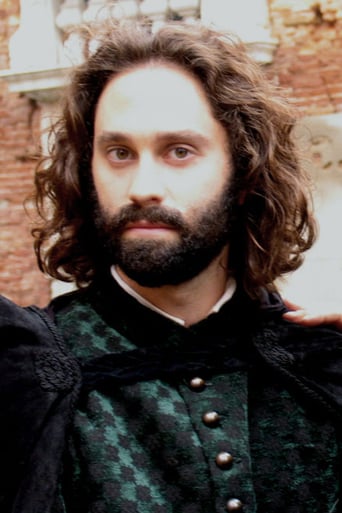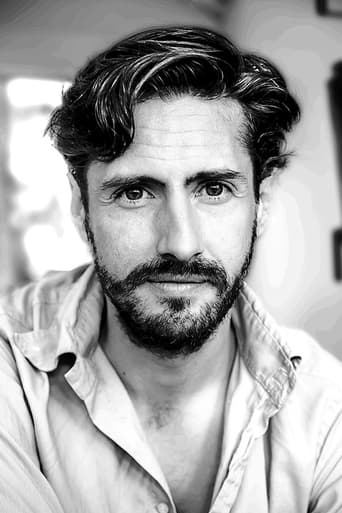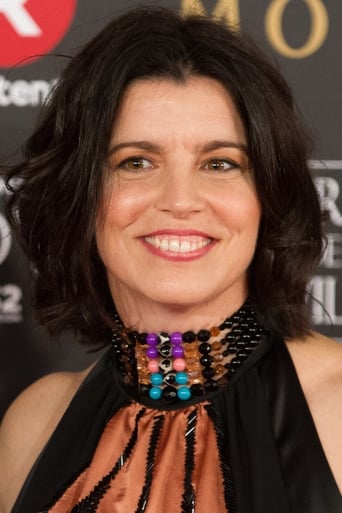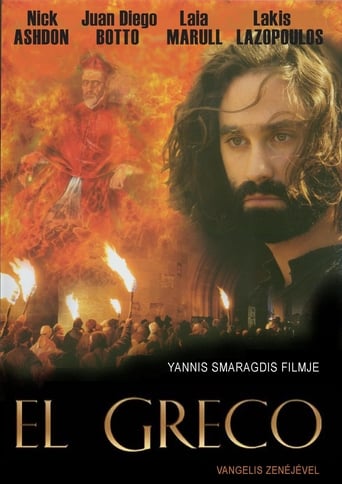
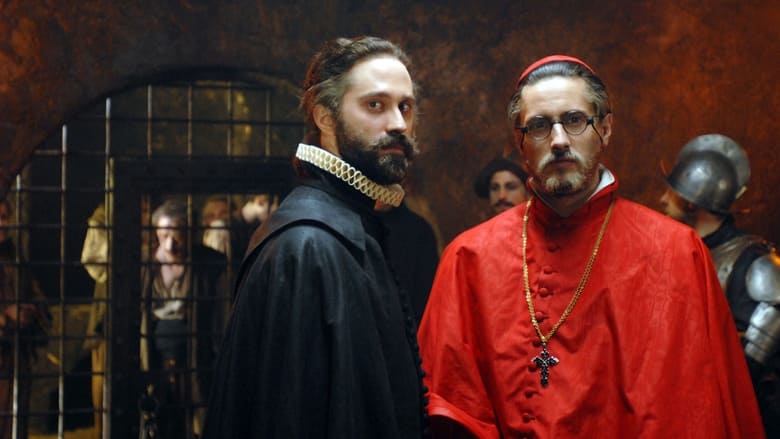
El Greco (2007)
The story of the uncompromising artist and fighter for freedom, Domenicos Theotokopoulos, known to the world as "El Greco".
Watch Trailer
Cast
Reviews
Good story, Not enough for a whole film
The performances transcend the film's tropes, grounding it in characters that feel more complete than this subgenre often produces.
It's easily one of the freshest, sharpest and most enjoyable films of this year.
Like the great film, it's made with a great deal of visible affection both in front of and behind the camera.
An interesting story about the notorious painter , architect , sculptor and architect Domenicos Theotokopoulos, known to the world as "El Greco". El Greco was born in Crete , which was at that time part of the Republic of Venice, and the center of Post-Byzantine art . He trained and became a master within that tradition before traveling at age 26 to Venice, as other Greek artists had done. His works painted in Italy were influenced by the Venetian Renaissance style of the period, with agile, elongated figures reminiscent of Tintoretto and a chromatic framework that connects him to Titian . In 1570 he moved to Rome, where he opened a workshop and executed a series of works. During his stay in Italy, El Greco enriched his style with elements of Mannerism and of the Venetian Renaissance. In 1577, he moved to Toledo, Spain, where he lived and worked until his death. In Toledo, El Greco received several major commissions and produced his best-known paintings. El Greco's dramatic and expressionistic style was met with puzzlement by his contemporaries but found appreciation in the 20th century . El Greco is regarded as a precursor of both Expressionism and Cubism, while his personality and works were a source of inspiration for poets and writers .This is a costumer partially based on facts but predominates the slow-moving melodrama . Historic film about an uncompromising artist , El Greco/Nick Clark and his relationship to lovers and powerful people from Renaissance . The picture relies heavily on the loving relationships between El Greco and his women as Francesa/Dimitra Matsouka and Jerónima De Las Cuevas/Laia Marull as well as the patronage and subsequent confrontation to Niño De Guevara , the General Inquisitor/Juan Diego Botto , that was painted on a famous painting. This is a moving biography of the prestigious painter and fighter for freedom , including some fictitious elements . Glamorously as well as sumptuously photographed by Stavrou , and being lavishly produced by Greece and Spain . The motion picture was professionally directed Yannis Smaragdis and filmed with a pervasive melancholy that does for slow drama . The picture based on actual events , these are the followings : In 1577, El Greco migrated to Madrid, then to Toledo, where he produced his mature Works . At the time, Toledo was the religious capital of Spain and a populous city . In Rome, El Greco had earned the respect of some intellectuals, but was also facing the hostility of certain art critics . During the 1570s the huge monastery-palace of El Escorial was still under construction and Philip II of Spain was experiencing difficulties in finding good artists for the many large paintings required to decorate it. El Greco met Benito Arias Montano, a Spanish humanist and agent of Philip; Pedro Chacón, a clergyman; and Luis de Castilla, son of Diego de Castilla, the dean of the Cathedral of Toledo. El Greco's friendship with Castilla would secure his first large commissions in Toledo. He arrived in Toledo by July 1577, and signed contracts for a group of paintings that was to adorn the church of Santo Domingo el Antiguo in Toledo and for the renowned El Espolio. By September 1579 he had completed nine paintings for Santo Domingo, including The Trinity and The Assumption of the Virgin. These works would establish the painter's reputation in Toledo. El Greco did not plan to settle permanently in Toledo, since his final aim was to win the favor of Philip and make his mark in his court. Indeed, he did manage to secure two important commissions from the monarch: Allegory of the Holy League and Martyrdom of St. Maurice. However, the king did not like these works and placed the St Maurice altarpiece in the chapter-house rather than the intended chapel. He gave no further commissions to El Greco. The exact reasons for the king's dissatisfaction remain unclear. Some scholars have suggested that Philip did not like the inclusion of living persons in a religious scene; some others that El Greco's works violated a basic rule of the Counter-Reformation, namely that in the image the content was paramount rather than the style. Philip took a close interest in his artistic commissions, and had very decided tastes; a long sought-after sculpted Crucifixion by Benvenuto Cellini also failed to please when it arrived, and was likewise exiled to a less prominent place. In any case, Philip's dissatisfaction ended any hopes of royal patronage El Greco may have had . Lacking the favor of the king, El Greco was obliged to remain in Toledo, where he had been received in 1577 as a great painter. While "Crete gave him life and the painter's craft, Toledo a better homeland, where through Death he began to achieve eternal life" . On 12 March 1586 he obtained the commission for The Burial of the Count of Orgaz, now his best-known work. During these years he received several major commissions, and his workshop created pictorial and sculptural ensembles for a variety of religious institutions, as the commission of The Virgin of the Immaculate Conception and for the Hospital of Saint John the Baptist , creating notorious paintings as The Disrobing of Christ , The Assumption of the Virgin , THe Holy Trinity , The Virgin of the Immaculate Conception .. In his mature works El Greco demonstrated a characteristic tendency to dramatize rather than to describe and the strong spiritual emotion transfers from painting directly to the audience . El Greco's preference for exceptionally tall and slender figures and elongated compositions, which served both his expressive purposes and aesthetic principles, led him to disregard the laws of nature and elongate his compositions to ever greater extents, particularly when they were destined for altarpieces .
This was a big thing when it came out, fellow Greek readers will attest to that. It was aggressively promoted as both 'expensive' and 'prestigious', it seems a rare thing for Greek cinema. The story went that the filmmaker had to mortgage his own house to finance his vision, proof of bold artistic merit. The movie played theatrically for what seemed like endless months - to make back its partly government-subsidized budget the rumor goes, since little interest materialized abroad. Schools planned 'educational' trips to the cinema, probably for the same reason.How small it seems now. You can see loftier production values on TV, and probably much better acting and a less grating parade of profundities.What really offends though is the spirit behind the work. It's not that it is dull and completely without insight about its own craft. It is both these things, but that's a simple incompetence. I mean, here is a film about a man of extraordinary vision who wanted to paint with light, and the 'inspirational' film about him is wholly ordinary, as lush and spiritual as perfume. What poor use of Aris Stavrou, who once liked to puzzle (next to Nikos Nikolaidis) about texture and light.It's that Smaragdis hoped to capture a bit of Greek soul (not necessarily historical 'truth') and journey with it abroad, a noble aim. Capture us as we dream ourselves to be, feisty and passionate Zorbas, made pensive by centuries of hardship - a bit like Kusturica did for the neighboring Yugoslavs.The film is set in those centuries of foreign rule, Italian and Ottoman elsewhere. There was no Rennaisance allowed in those times, it would be good to note, no lofty national art as they could develop in the salons of Western Europe. Our painting was religious. Our theater was song and dance, from Thrace to Crete. The collective soul had to pour that way, which is why they still persist and resonate so strongly in these parts - as elsewhere in the former empire.You will know it's all phony by watching the scene of proud Cretans dancing after a skirmish with the Italians. You'd think, if there was a bit of ancient Greek song rising from the earth, it would be in that scene. If you are ever in the region, go to a Cretan wedding or folk fest, in fact anywhere in rural Greece during times of celebration. Then watch the posturing in the film. Dismal.If you want to know a bit about these things, to see actual Balkan spirit, seek out a man called Sergei Parajanov. He was Armenian who made films under Soviet rule, but it is the same soul he captured.
Well, I guess I never saw such a pathetic movie. The actors are absolutely ridiculous, acting at a tragi-comic level which would be hilarious if it would be volunteer. The directing is absolutely show-off, with a pointless use of multiple huge movements of camera, but without defined subjects, which creates a deep impression of emptiness in any single shot of this movie. To make a Hollywood-like movie doesn't consist only in moving the camera in big panoramic shots showing lots of expensive (though sometimes quite "cheap looking") costumes.There's no use of the image's depth, no correct framing, it is just a piece of work trying to achieve the aesthetic of the American productions, but without the knowledge of cinema necessary to achieve such a production.But the worst is still to come: the dialogues, the characters and of course, because they have to act it, the actors.The guy who plays Titiano is doing quite well... except that he has for the most 3 lines to say. And there's nothing presenting the influence he had on El Greco, whereas he could have lift the movie by his good acting. That's all. All the rest is pathetic.The dialogues are like coming from a Monthy Python 3rd degree film (where do they find such a tragically bad writer, by the way? Did this guy ever saw "real" movies? Is he watching only Greek serials?), and anyway the actors would certainly not have been able to put good dialogues into live action (at least considering the low performance they achieved all the movie long...).But the most disappointing part is the characters: the evolution of the relations between the two main characters (El Greco and De Guevara), which could have been interesting, is treated without any nuances (El Greco super white shiny hero and De Guevara super bad black dark guy... the Light on one side and the Shadow on the other... even George Lucas was more subtle in Star Wars when he created the characters of Darth Vador and Luke Skywalker!!! although they were pretty poor characters...;-)Stays the striking line: "Can light overcome darkness?" Thanksfully, El Greco is dead and will never discover how strong becomes darkness when cinema comes to the hands of such illiterate "artists". Light in this movie? Maybe the light of lovely Crete at the beginning (when it is not cheap computer generated images), and through a window at some point, but that's all. Everything else consists in deep darkness!I didn't even mention the hilarious (thus tragic, since they are aiming at being serious!) acting of Dimitra Matsouka and Lakis Lazopoulos, who should better stay on TV...as the director, the dialogs writer and the script-writer.TV is a cheap entertainment, cinema is an art. Some people should understand it before waisting money.El Greco getting an Oscar? Guys, let's be serious: Nyfes was a real movie and didn't get any. Politikh Kouzina was an interesting period movie, and didn't win anything. How could El Greco be even just nominated. It would be insulting the cinema community! Hollywood might produces awful and stupid movies, but at least most of the time they hire guys who know a bit what is cinema!If "Plan 9 from outer-space" wasn't so unreachable, El Greco could certainly compete for the worst movie ever (at least for the "Worst Serious Expensive Movie Ever").
Just as this film has a lot of elements that can easily make it aspire to greatness, it is not without visible flaws and weak moments. Nonetheless in the end, it rises above its own flaws, leaving a very positive after-taste. I just feel sad I did not see this film earlier in the theaters, and only managed to see it recently on DVD. At the same time, I feel sad this film didn't take it one step further and become what it was so close to achieving.For people waiting to explore the artist's character in-depth, understand his passions or his motivation, or admire a kaleidoscope that unlocks the artist's mind to the viewer, disappointment awaits in the corner, because this film does not explore those elements to a satisfactory level.Nonetheless, the film does not really boast any of that, to start with. The story of it is staged early and very deliberately in the scheme of a broader conflict between light and darkness, and the portrayal of the artist is shown almost entirely through that prism. And it delivers this very well.Right from the start, an intense scene puts us right in the proper atmosphere, and then the movie continues with a narrative that eventually carries us out seamlessly back into the initial scene, adding context, and appropriately coloring the characters in the meantime.Costumes are fitting, although their quality ranges, and sometimes poor costume quality sneaks in. But not something that detracts from the bigger picture.The music is great, of course, and adds a lot of value to the film.The scenes are seamless and tie well with each other and the narrative that goes on in the background. The scenery is also attractive and adds a lot of character.The actual script seems to have a lot of weak points (though that is not uncommon in Greek productions, and with this one it is still miles ahead of others).The first serious issue of the script is the mix of languages. It probably started as a good idea, trying to portray linguistic differentiation, but soon enough, poor accents, weak dialogue (perhaps cut down even further so as not to linguistically challenge the actors) happens almost the entire time and detracts from the film.The second issue is the dialogues themselves. The actors are great, and perfectly capable of portraying a lot more than the dialogues allow them to say. This is a shame.The script's saving grace is the English narrative, which is respectable, and the ability of the actors (and the director, sometimes) who manage to convey with emotion what the script's words aren't adequate to show.The film is otherwise well-laid out, despite some lighting issues (some scenes feel far too bright), and sound issues (audio ranges too wildly between near-whisper and wild shouting and banging).I didn't have to try to overlook the shortcomings of this film in order to enjoy it. I certainly enjoyed watching it, and was glad I did, despite all the shortcomings.Oscar nomination? Heh, perhaps not. But definitely a respectable, enjoyable film with some good moments, that is certainly worth watching.
